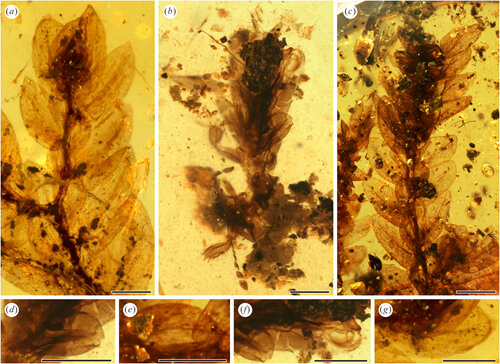Animals have evolved several strategies in prey-predator interactions due to selective pressures, such as mimicry and camouflage. Both mimicry and camouflage enable animals to effectively reduce the probability of detection by prey and predators.
Plant-like mimesis and debris-carrying camouflage are rather common adaptations within insects. Plant-like mimesis is an effective way to hide by mimicking leaves, sticks, or bark. In debris-carrying camouflage, larvae match their life-supporting environment by decorating themselves with exogenous debris.
Recently, doctoral student Xu Chunpeng, supervised by Prof. Wang Bo from the Nanjing Institute of Geology and Paleontology of the Chinese Academy of Sciences (NIGPAS), and their collaborators from Wuhan University and the University of Kansas identified a pygmy mole cricket (Tridactylidae) mimicking spike mosses or leafy liverworts from mid-Cretaceous (approximately 99 million years ago) Kachin amber through Siamese Neural Network analysis. The study was published in Gondwana Research on August 2.
The newly found pygmy mole cricket Phyllotridactylus Wangi exhibits a morphological resemblance to leafy liverworts and spike mosses in gross morphology, including the shape of leaves. The most striking feature is the remarkable inflation of the metafemur, which resembles leaf lobes of some spike mosses laterally or dorsolaterally. Additionally, the inflation made by the mesofemur and mesotibia also resembles the central leaflets of spike mosses of leafy liverworts.
In their previous study, published in Historical Biology, the researchers developed a new method using the Siamese network of deep learning to measure the dissimilarity between two images by calculating the distance between image pairs and provide a dissimilarity value.
Our method provides a new model for quantifying the mimesis of fossil insects. Mesozoic plant mimesis in Tridactylidae was supported by our Siamese Network analysis.
Additionally, the researchers reported a diverse insect assemblage with debris-carrying camouflage from mid-Cretaceous Kachin amber, comprising six nymphs of Psocodea and a nymph of Gelastocoridae.
Psocodean nymphs have belonged to three Morphotypes, which might stick sand and organic material with their setae on their backs. Gelastocorid nymph shows a very flat form, being both dorsally and ventrally covered with unequal-sized sand grains and plant debris. These fossils demonstrate that most extant debris-carrying insects had evolved exogenous camouflage by the mid-Cretaceous.




0 Comments